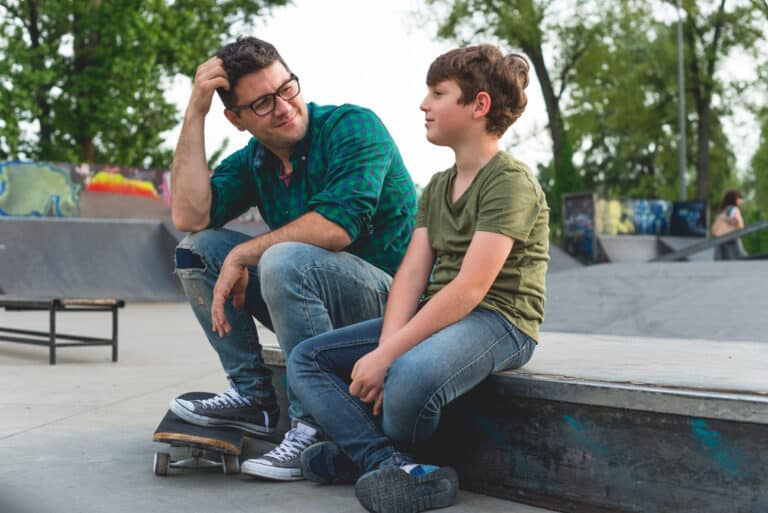Parenting a child who has experienced trauma can bring both challenges and hope. Understanding how trauma shapes a child’s emotions and behavior is the first step toward healing. On this page, you will find guidance and tools to help you create safety, build trust, and support your child’s resilience. With patience, care, and consistency, you can nurture recovery and help your child move toward a healthier, more confident future.
What Is Trauma?
Trauma refers to extreme or chronic stress that overwhelms a person’s ability to cope and results in feeling vulnerable, helpless, and afraid.
Trauma is not just what happened, but how the experience affects a person. The same event can impact people in different ways.
Examples of experiences that can cause trauma include:
- Being in a serious accident.
- Experiencing a natural disaster like a hurricane.
Seeing violence at home. - Being harmed by abuse.
Growing up without a stable place to live or enough food. - Living with a person with untreated mental illness or addiction.
You Make A Difference: 7 Ways to Help your Child
Childhood trauma is more common than we think. Some traumatic events, such as natural disasters or the death of a loved one, are beyond our control. However, you have the power to support your child in many ways as they heal.

1. Build a sense of safety.
Children feel safer when they know what to expect. A regular routine can help them feel more secure. For example:
- Dress and brush teeth every morning
- Have a regular bedtime and rituals, like reading stories before bed.
2. Create opportunities for competence.
During these times, children may feel helpless. Teaching age-appropriate skills, like tying shoes or doing laundry, can help build their confidence.
3. Listen.
Simply listening to children can help them feel safe and supported. Invite your child to share how they feel and give them your full attention. Listen without judging and thank them for confiding in you.
4. Offer different ways to express feelings.
Sometimes it is hard for children to talk about their feelings. Help them share what’s in their heart and mind through activities like drawing, playing with Play-Doh, listening to music, or dancing.
5. Be there.
Work hard to be a steady, loving presence in your child’s life. Only make promises you can keep. Use kind words and actions, like hugs and smiles, to show your love often.
6. Take care of yourself.
Loving a child that has experienced trauma can be challenging. Taking care of yourself makes it easier to care for others. Simple things like taking a walk, drinking water, or calling a friend can help you refuel.
7. Know when to get help.
If your child’s behavior changes dramatically or causes big problems at home, reach out for help. Talk to your doctor or download this handout.
Raising Resilience: Parenting Through Trauma
¿ Qué es el trauma?
El trauma se refi ere al estrés extremo o crónico que abruma la capacidad de afrontar la situación de la persona y da como resultado el sentirse vulnerable, desesperanzado y asustado.
El trauma no es solo lo que ocurrió, sino también cómo la experiencia afecta a la persona. El mismo evento puede impactar a las personas de maneras diferentes.
Ejemplos de experiencias que pueden causar trauma incluyen:
- estar en un accidente grave.
- pasar por un desastre natural, tal como un huracán.
- ver violencia en casa.
- ser agredido por el abuso.
- criarse sin un lugar estable donde vivir o sin sufi ciente comida.
- vivir con una persona con una enfermedad mental o adicción que no
recibe tratamiento.
Usted puede ser la diferencia
El trauma infantil es más común que pensamos. Algunos eventos traumáticos están fuera de nuestro control, tales como: los desastres
naturales o el fallecimiento de un ser querido. Sin embargo, usted tiene el poder de apoyar a su hijo de muchas maneras a medida que van sanando.

1. Crear un sentido de seguridad.
Los niños se sienten más seguros cuando saben que esperar. Una rutina regular les puede ayudar a sentirse más seguros. Por ejemplo:
- vestirse y cepillarse los dientes todas las mañanas.
- tener una hora de dormir regular y rituales como leer un cuento antes de dormirse.
2. Crear oportunidades para ser competente.
Los niños se pueden sentir indefensos en estos momentos. Enseñar habilidades de acuerdo con la edad, tales como: atarse los zapatos o lavar la ropa, pueden ayudarles a crear confi anza en sí mismos.
3. Escuchar.
Sencillamente escuchando a los niños les puede ayudar a sentirse seguros y apoyados. Invite a su hijo a compartir cómo se siente cuando esté completamente enfocado en el/ella. Escuche sin juzgar y agradezca la confi anza que le tienen
4. Ofrezca diferentes maneras de expresar las emociones.
A veces a los niños les cuesta hablar sobre sus emociones. Ayúdeles a compartir lo que tienen en su corazón y mente a través de actividades como dibujar, jugar con plastilina, escuchar música o bailar.
5. Estar presente.
Trabaje duro para ser una presencia constante y cariñosa en la vida de su hijo. Solo haga promesas que puede cumplir. Utilice palabras y acciones amables como los abrazos y sonrisas a menudo para demostrar su amor.
6. Cuidar de sí mismo.
Querer a un niño que ha vivido un trauma puede ser un desafío. Es más fácil cuidar de los demás cuando uno se cuida a sí mismo. Cosas sencillas como salir a caminar, tomar agua o llamar a un amigo pueden recargar sus pilas.
7. Saber cuándo buscar ayuda.
Busque ayuda si el comportamiento de su hijo cambia de forma drástica o causa problemas signifi cativos en casa. Hablar con su médico, o descargar este folleto.



